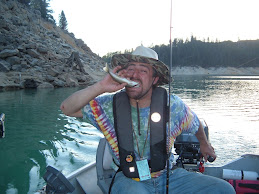
Mercury Marine outboard motors
From Wikipedia, the free encyclopedia
Company beginnings
The company began when engineer Carl Kiekhaefer purchased a small outboard motor company in Cedarburg, Wisconsin. Kiekhaefer's original intention for the Kiekhaefer Corporation was to make magnetic separators for the dairy industry. The purchase included 300 defective outboard motors. Kiekhaefer and a small staff of employees rebuilt the motors and sold them to a mail-order company. The motors were so sound that the buyer purchased more. Kiekhaefer designed motors that withstood the elements better than his competition, and called the motor Mercury after the fleet-footed Roman god. Kiekhaefer took 16,000 orders at the 1940 New York Boat Show.
World War II
World War II changed the corporate climate, and Kiekhaefer sought a government contract to design two-man air-cooled chainsaws. Army engineers were unable to design a lightweight motor. Kiekhaefer designed a new lightweight chainsaw in 2 months. The Kiekhaefer powered chainsaw was able to cut through a 24-inch (610 mm) green log in 17 seconds, while it took the nearest competitor 52 seconds. Mercury was awarded the contract, and was the world's largest chainsaw manufacturer by the end of the war.
Post-war history
Mercury foresaw Americans interest in boating would increase after the war. Kiekhaefer introduced a 19.8 cubic inch, 10 horsepower (hp), two-cylinder alternate firing design motor at the 1947 New York Boat Show called the "Lightning" or KE-7.
NASCAR racing
Main article: Carl Kiekhaefer
Kiekhaefer decided to promote his company by owning a NASCAR and AAA team. The team dominated NASCAR Grand National (now Busch Series) (at one point winning 16 straight races), even though it only competed in 1955 and 1956. The team won the 1955 and 1956 NASCAR championships with drivers Tim Flock and Buck Baker. One of Mercury's innovations was using dry paper air filters, which are still standard in automobiles today.
1950s through 1970sIn 1957 Kiekhaefer started testing at a Florida lake he called "Lake X" in order to keep the location secret. Later that year the company designed a new 60 hp (45 kW) motor named "Mark 75." Two Mark 75 motors set an endurace record by running non-stop for over 50,000 miles (80,000 km) over 68 3/4 days on Lake X. The motors were refueled as they ran, and averaged 30.3 miles per hour.
In 1961 the company merged with the Brunswick Corporation.
The company introduced the MerCruiser motor at the 1961 Chicago Boat Show. The motor would later take over 80 percent of the world market.
Carl Kiekhaefer resigned as President of Kiekhaefer Mercury in 1969, and the name was changed to Mercury Marine. During this time, Mercury produced snowmobiles, like many other companies in the late 60's. The first ones incorporatd a 250 cc two man chainsaw engine. In 1971, they came out with the Rocket, and Lightning models. These sleds combined aluminum tunnels with Canadian Curtiss Wright (CCW) engines. The Rocket was a 340, and the Lightning a 400 with electric start. By 1972, Mercury started production of the Hurricane, a lightning fast sled with slide suspension (as opposed to bogie wheel). This started off a new era in snowmobile construction for the whole industry and the sled's basic format set up what we see today in modern snowmobiles. Mercury was renowned in the 1970s as one of the best racing and performance snowmobile manufacturers, as well as an industry leader in marine engine production.
All about Outboard Motors






